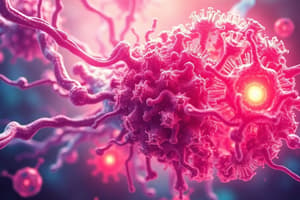Podcast
Questions and Answers
What is the primary focus of pharmacodynamics?
What is the primary focus of pharmacodynamics?
- Study of drug interactions in the bloodstream
- Study of drug elimination from the body
- Study of drug absorption in the body
- Study of the physiological effects of drugs on cells (correct)
Which of the following accurately describes an antagonist?
Which of the following accurately describes an antagonist?
- A drug that produces a significant therapeutic effect
- A drug that only works in the presence of an agonist
- A substance that enhances the body's response to a receptor
- A substance that blocks the receptor and inhibits physiological effects (correct)
What does the term 'bioavailability' refer to?
What does the term 'bioavailability' refer to?
- The process of drug excretion from the body
- The maximum concentration of a drug in the bloodstream
- The extent and rate at which an active ingredient or active moiety is absorbed and becomes available at the site of action (correct)
- The time it takes for a drug to reach its maximum effect
Which factor affects the rate of drug absorption from the gastrointestinal tract?
Which factor affects the rate of drug absorption from the gastrointestinal tract?
Why are some drugs recommended to be taken on an empty stomach?
Why are some drugs recommended to be taken on an empty stomach?
What does drug tolerance imply?
What does drug tolerance imply?
Which of the following is true about the onset of action for a drug?
Which of the following is true about the onset of action for a drug?
Which of the following statements about excretion is correct?
Which of the following statements about excretion is correct?
What does the half-life of a drug indicate?
What does the half-life of a drug indicate?
Which statement accurately describes the concept of steady-state accumulation?
Which statement accurately describes the concept of steady-state accumulation?
What is the normal range for creatinine clearance, indicating good renal function?
What is the normal range for creatinine clearance, indicating good renal function?
Which of the following describes absolute contraindications?
Which of the following describes absolute contraindications?
What defines potentiation in drug interactions?
What defines potentiation in drug interactions?
Which of the following best describes nephrotoxicity?
Which of the following best describes nephrotoxicity?
How can hypersensitivity reactions manifest after drug administration?
How can hypersensitivity reactions manifest after drug administration?
What is the primary concern when administering magnesium sulfate to pregnant women?
What is the primary concern when administering magnesium sulfate to pregnant women?
Flashcards are hidden until you start studying
Study Notes
Pharmacodynamics and Drug Action
- Pharmacodynamics examines how drugs influence cell physiology and the body's response to drugs.
Receptors
- Receptors are proteins or nucleic acids influencing physiological and metabolic activities.
- Agonists/Activators: Bind to receptors and produce pharmacologic effects.
- Antagonists/Blockers: Prevent cellular effects by blocking receptor activity.
Pharmacotherapeutic/Indication
- Understand the intended drug effects, including toxic side effects.
- Example: Minoxidil is used to prevent hair loss.
Pharmacokinetics
- Focuses on how the body affects drugs, including absorption, distribution, metabolism, and excretion.
- Onset: Time to reach minimum effective concentration.
- Peak: Time when the drug has maximum effect.
- Duration: Length of time the drug remains effective.
Absorption
- Refers to how drugs enter the bloodstream.
- Bioavailability: Degree and rate at which a drug is absorbed and reaches target tissue.
Factors Affecting Absorption Rate
- Dosage Forms: Includes liquids, suspensions, capsules, tablets, coated, and enteric-coated tablets.
- Route of Administration: Sublingual administration is faster; lipid solubility facilitates absorption.
- GI Motility: Food can delay gastric emptying, impacting drug absorption. Drugs should generally be taken before or between meals.
Specific Drug Administration Guidelines
- Some drugs should be taken on an empty stomach with lots of water, such as:
- Acetaminophen, cephalosporins, isoniazid, rifampicin.
- Other medications may be taken with food to minimize gastrointestinal irritation.
Plasma-Protein Binding
- Drugs may bind to plasma proteins, impacting their efficacy and metabolism.
Key Terms
- Cumulative Effect: Increased response from repeated doses.
- Drug Tolerance: Diminished response to a drug over time.
- Drug Resistance: Failure of a drug to have the intended effect.
- Drug Dependence: Client's need for a drug.
Excretion
- The primary route of drug elimination is via the kidneys.
- Probenecid is used with penicillin to reduce excretion, while antacids can increase aspirin elimination.
Half-Life
- Indicates how long a drug remains in the system; usually, a drug is considered eliminated after about five half-lives.
Steady-State Accumulation
- Achieved when drug intake equals elimination, leading to consistent therapeutic levels.
Drug Clearance
- Creatinine Clearance is the best renal function indicator; normal values range from 0.6 to 1.2 mg/dL.
Contraindications
- Absolute Contraindications: Drugs that should never be administered.
- Relative Contraindications: Drugs to avoid in specific circumstances (e.g., pregnancy).
Caution with Drug Administration
- Certain drugs require caution, such as magnesium sulfate in pregnant women.
Drug Interactions
- Additive Effect: Combined effect of drugs; e.g., hydrochlorothiazide and BP reduction.
- Potentiation/Synergy: One drug enhancing the effect of another, e.g., Vistaril and Demerol.
- Antagonism: One drug reducing the effect of another, e.g., insulin and steroids.
Side Effects and Toxicity
- Side Effects: Expected but not always harmful (e.g., nausea).
- Toxicity: Potentially harmful effects, such as nephrotoxicity and hepatotoxicity.
Hypersensitivity Reactions
- Occur when patients are sensitive to drug effects, while allergic reactions involve immune responses (e.g., rash, anaphylaxis).
Studying That Suits You
Use AI to generate personalized quizzes and flashcards to suit your learning preferences.




